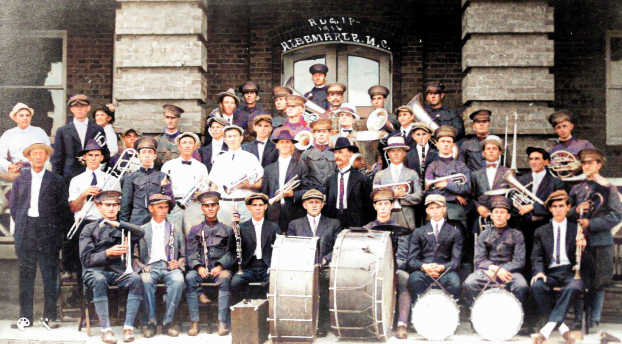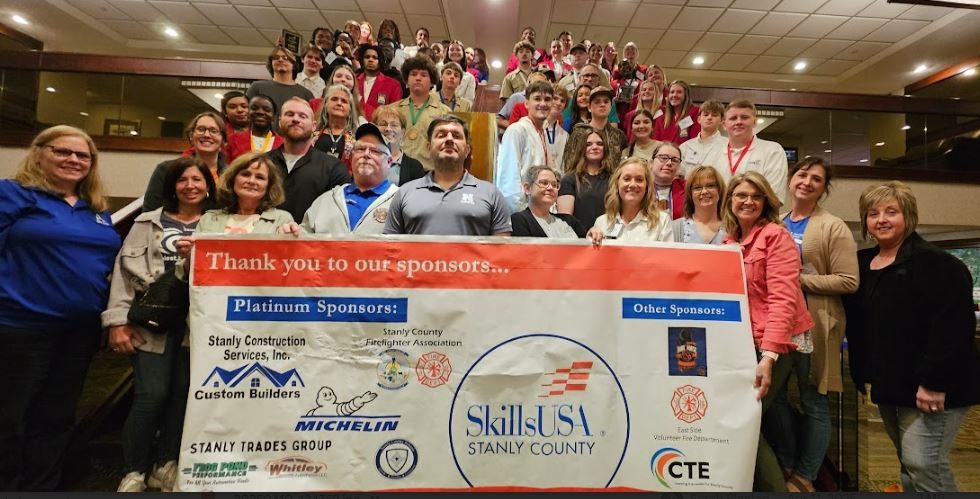History Center finds success with virtual exhibits, latest one colorizing, enhancing old photographs
Published 2:43 pm Thursday, October 7, 2021

- The Wiscasset Mill Band standing on the steps of the Wiscasset School in Albemarle around 1916. Photo courtesy of Megan Sullivan.
|
Getting your Trinity Audio player ready...
|
Stanly County History Center director Megan Sullivan attended a small museum conference in Maryland in February 2020 where she took part in a workshop focused on using technology to create virtual, immersive exhibits for the public to enjoy.
She took notes about what she learned but didn’t necessarily plan on implementing any of it anytime soon.
Then, just a few weeks later, the COVID-19 pandemic hit and public places like museums were quickly closed.
Sullivan went back to her notes.
“I’m like, ‘Oh, this could be a really good technology to utilize,’ ” she recalled.
And that’s exactly what she did thanks to the website ThingLink. It helps users create engaging 3D visual tours, allowing people access to physical places while in virtual settings. Much of the legwork was completed with her iPhone.
Sullivan has already created two such exhibits during the pandemic that were also open to the public for in-person viewing. The first was about the history of baseball, both in Stanly County and across the country, while the second detailed the county’s history utilizing several historical artifacts and treasure troves residents had donated to the museum over the years.
Sullivan recently opened her third virtual exhibit for people to enjoy from the comforts of their homes. “Live and in Technicolor” features around 60 black and white photographs dating as far back as the 19th century that have become digitally enhanced and colorized. The in-person exhibit began earlier this summer and ran through August.
Sullivan utilized tools from the genealogy website MyHeritage to digitally animate the faces in historical photos, especially people’s facial features, along with bringing blurry and low-resolution photos into focus by increasing their resolution and sharpening the faces that appear in them.
“We have so many pictures in our collection and I was like, ‘Gosh, this would be really great and interesting to be able to utilize this with our collection,’ ” Sullivan told the SNAP in May, when the in-person exhibit was getting ready to open.
Though the pictures that were selected to become digitally enhanced were not part of a coherent theme or narrative, many of them involve groups of people or portraits of individuals along with streetscapes of late 19th century and early 20th century downtown Albemarle.
The virtual exhibit offers a 360-degree panoramic view of all of the photographs — both the black and white original and the colorized, digitally enhanced version — along with corresponding artifacts such as an early 20th century wedding dress and red theater seats from the old Alameda Theater.
Some examples include a 1940s picture of the Alameda Theater playing the movie “My Love Came Back,” starring Olivia de Havilland and Jeffrey Lynn; the Wiscassett Mill Band in 1916 standing on the steps of the Wiscassett School in Albemarle; employees and customers posing in front of Morrow Brothers and Heath Company in 1910; and The Badin Theater in the 1920s.
- Alameda Theater around 1940, showing “My Love Came Back,” starring Olivia de Havilland and Jeffrey Lynn. Photo courtesy of Megan Sullivan.
- The Badin theater circa 1920s. Photo courtesy of Megan Sullivan.
- Employees and customers standing in front of Morrow Brothers and Heath Company, circa 1910. Photo courtesy of Megan Sullivan.
“You’ll be able to peruse and really take your time examining the photographs from the safety of your room home,” Sullivan said. “A lot of these photographs deserved to really be studied longer.”
Since the exhibit first opened a few months ago, Sullivan said the reception has been really positive with many people telling her they have gotten “chills and goosebumps on their arms” after viewing the incredibly realistic photos.
“I think this technology helps humanize these people…this really gives them an added dimension,” Sullivan said.
Even though the exhibit will no longer be around for people to view in-person at the museum, Sullivan has reason to be optimistic that people will take the time to view it online. More than a year after launching, 430 people visited the baseball virtual exhibit in August, Sullivan said, while 520 people visited the ancient history exhibit, which opened this past spring.
More than 10,000 people have accessed the museum’s website to visit either of the virtual exhibits over the past year, Sullivan said.
“I’m very pleasantly surprised that even though these exhibits have been up for more than a year, people are still going back to visit them online.”
The plan is to keep each of the virtual exhibits up indefinitely on the museum’s website for people to continue to enjoy, Sullivan said. Even once the pandemic ends, Sullivan said she would like to continue creating virtual exhibits.
“It’s really nice that even though the exhibits are down physically, it’s nice that they’re still living on and people are still experiencing them and hopefully learning from them,” she said.









